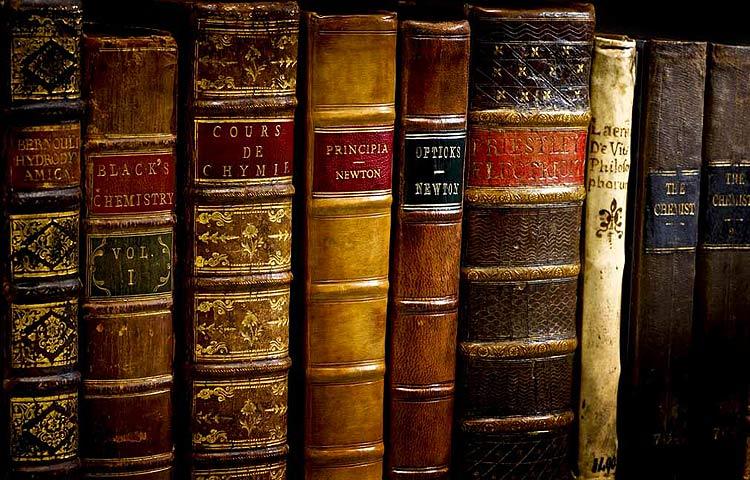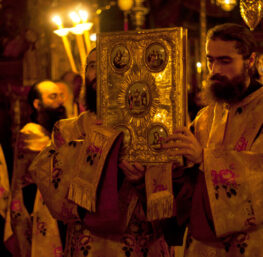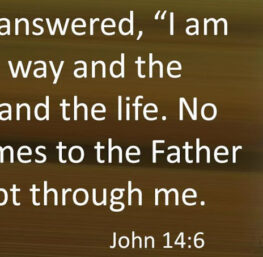 by Tom Jay –
by Tom Jay –
A truly classical and Christian education must link the pursuit of truth, goodness, and beauty to the One Who is truth, goodness, and beauty.
“The least initial deviation from the truth is multiplied later a thousandfold.” Aristotle wrote this in the fourth century B.C. in a text called On the Heavens. Sixteen hundred years later Thomas Aquinas began his treatise On Being and Essence by paraphrasing Aristotle: “Because a small error in the beginning grows enormous at the end.…” The application of this wisdom to the moral life might be rather obvious. Tell a lie once, however small, and you will probably end up telling more. While it’s easy to see, in the realms of space or morality, how a slight error can lead to enormous complications later, these maxims are not only meaningful for astrophysicists and theologians. Teachers and school administrators would do well to reflect on these words as well.
In my classroom, a student will occasionally say something like, “What’s the big deal about a comma? Does it really matter?” A parent might complain when I take a point off their child’s math test because he wrote 28 cm, instead of 28 cm2. “Clearly, he knew the answer, as you can see from his work.” The parent is asking the same question: Does it really matter? My answer is always, “Yes, it absolutely matters because 28 centimeters is not the same thing as 28 square centimeters.” That is simply the truth. If teachers don’t communicate this consistently to their students and the students’ parents, we are acquiescing in a tendency toward cavalier mediocrity and the importance of truth withers away. If we decide how we say or write things does not matter, we will soon show the same disregard for what we say or write. Augustine put it another way observing that although rain drops may be small, together they can swell a river into a flood. This phenomenon is occurring in America’s schools, public and parochial.
The least initial deviation from the truth is multiplied later a thousandfold.
How have our nation’s public schools reached the point where many of them no longer teach grammar? It has happened because schools deviated from the truth about language, which Josef Pieper characterized as a participation in truth. This presupposes contemplation and a degree of clarity in articulation. Clarity in written articulation presupposes an order in the symbols used to communicate an idea, what we call language. When schools began prioritizing self-expression, grammar became irksome, restrictive. Language is no longer about a reciprocal participation in truth, a means of communion, but rather a tool forced into the service one’s own sentimental and fickle demands. Commas, apostrophes, and correct capitalization now are seen as anachronistic obstacles rather than manifestations of an order inherent in language that aid clarity and facilitate mutual understanding. It was only a matter of time before grammar was jettisoned altogether. And, since excellence in writing is no longer required, neither is excellence in thinking because the two are inextricably joined. Couple this with an endless selection of graphic organizers and bookless curricula, and who needs to write anymore?
State boards of education packed with ostensible experts also deviated from the truth. When “the test” began demanding knowledge of elements of literature, for example, reading became analysis. Find the theme, graph the plot, describe the resolution. Let’s dispense with the quaint notion of our students sitting down together to talk about a story, why their hearts cry out for Oliver Twist or why they feel conflicted about Pinocchio. Training students to explicitly define terms does not foster a love for literature, nor does it provide a means of measuring their ability to understand and engage with a great story. Over time, in fact, it has the opposite effect. It kills the sense of wonder and erodes the imaginative faculty of a child, subsequently causing a gradual closing of their minds to any possibility of supranatural realities. If we want our students to understand how great writers create great literature, let’s give them Aristotle’s Poetics when they are developmentally ready for it.
children should be immersed in the wonderful worlds of fairytale, myth, folklore, and poetry.
In the meantime, children should be immersed in the wonderful worlds of fairytale, myth, folklore, and poetry. Focusing young students on the mechanics of a story rather than the story is like giving them a gift and ordering them not to open it to find the surprise hidden inside, but rather to analyze the box, wrapping paper, and ribbon, and then describe it to you in writing, which they will not be able to do because we stopped teaching them how to articulate their thoughts clearly in written language. Proponents of classical education have been warning that the new national standards currently under consideration will turn reading into research, as up to 70 percent of the content mandated will be comprised of informational text. “A small error at the beginning.…”
Where did the first small error occur? Jacques Barzun wrote that “the error began with the replacement of the word ‘pedagogy’ with the word ‘education’.” Barzun acknowledges a certain lack of beauty in the word pedagogy, but defends it by saying the word “sticks to the point of teaching.” The word education, on the other hand, “properly refers to a completed development, or the whole tendency of the mind toward it.” Barzun views this shift as an error because “thinking that we can give an education, we make wild claims and promises and forget to teach what is teachable.” Also forgotten, Barzun observes, is that education, properly understood, means the student assumes most of the responsibility, not the teacher. The teacher’s responsibility is pedagogy. The result of the confusion leads to writing lessons or art classes, for example, aimed at self-expression merely. Students will become poets and painters while understanding nothing of poetry or technique.
Each teacher must, Merlin-like, magically create this transformation. Too many of them think they can because they have been fed a steady diet of the latest methodology —complete with its own system of cryptic terminology—devised by a Ph.D. at a state university. This is where the absurdities originate. The full perspective of education as a twelve to sixteen year prospect involving a team comprised of parents, many teachers, and the student himself, is either forgotten or ignored. Never mind memorization, recitation, technique, and grammar. They must express themselves as poets and painters, and they must do so now.
Catholics schools have been affected, too. Catholic [and Orthodox and other Christian] institutions ought to be bulwarks against the secular absurdities denigrating public education, yet they have too often been complicit in advancing them. This phenomenon began with the liberalization and subsequent decimation of the religious orders, which had succumbed to the deviant claims of modern feminism. Catholic schools turned to the laity for teachers. But, the Catholic laity was quickly absorbing the errors of moral relativism. Although the external trappings of Catholic identity remained in place, internally Catholic schools began to resemble public schools. The fact that Catholic School Offices in dioceses all over the country now find it necessary to form committees to assess and develop Catholic identity in their schools is a disheartening indication that something integral to Catholic education has been lost. Other than the school’s name and a weekly mass, parents can no longer be certain their child is, in fact, attending a Catholic school, even if they are paying $4000 per year in tuition.
Christian institutions ought to be bulwarks against the secular absurdities denigrating public education, yet they have too often been complicit in advancing them.
Well intentioned efforts to reverse the deterioration of Catholic education frequently veer into a false dichotomy resulting from the same confusion about pedagogy and education noted by Barzun. It should not be assumed a pastor, or even a bishop, understands education. It’s a hard thing to run a school well. However, the leadership of too many Catholic schools began looking to the languishing public sector for ideas. State legislatures are partly to blame for the general decline because, by defining successful education according to an interpretation of data based on flawed standardized tests, they encouraged public and parochial schools to do the same. Thus, Catholic schools have also become susceptible to making false promises about what they can do, and adapted too readily to the standardized demands of the state by uncritically incorporating the methodologies of the “experts.” In this Catholic schools have, like the public schools, reduced their students to data points.
This false dichotomy results in monolithic approaches to reform within the school focused either on academics or spiritual formation. Neither extreme is good because it excludes the rightful place of the other, diminishing the value of both. In the first instance, the Catholic schools become data-driven, test-focused institutions with little concern for each child’s soul and ultimate destiny. In the latter case, the pastor assumes a myopic perspective that sees the school only as a seminary for children. Curriculum in such a school is only useful as a means for forming young people who consider no other calling in life but priesthood or religious life. In both scenarios, poor hiring decisions are made which impoverish the overall life of the school both spiritually and intellectually. When the only concern is academics, classrooms are led by men and women who often see Church teaching as optional and the Faith as little more than quaint stories we tell to the little ones. When the only concern is catechesis, classrooms tend to be led by unthinking zealots who make an idol of the Church. The only geometry such teachers concern themselves with is the 900 angle they expect with each genuflection. They raise the axiom lex orandi lex credendi to the height of pharisaical obsession, which leaves the students impoverished intellectually, and skeptical about the Christian message of love.
Catholics schools have their own tradition to pattern their schools upon. That tradition is generally called the liberal arts. In classical terms, it is called the trivium and quadrivium methods. A properly organized Catholic school ought to provide spiritual formation and intellectual formation simultaneously by immersing its students in the manifestations of God’s love for us found in the good news of the Gospel, and in the ordered beauty we see all around us, from the atom to the most expansive galaxies in space, from a knowledge of American history to a well-crafted sentence. When I was a middle school teacher at a Catholic school, I used to remind my colleague who taught math and science that he was, in a certain respect, better positioned to evangelize our students than I was as the religion teacher. My students expected me to talk to them about God and the Church. Yet, to find those same theological truths written into creation itself! What is the study of math, science, and grammar if not the discovery of a rational, intelligible order? It must not be left to the religion teacher alone to evangelize students in a Catholic school. Moreover, we must stop viewing grammar as a boring set of rules. Grammar is the revelation of an order inherent in language which makes possible that “sweet discourse” Adam longs for in Milton’s Paradise Lost.
Catholic schools can find some useful models for renewal of their own schools within the growing movement toward classical education. There are now many private and charter institutions patterned upon the classical model. Charters like Great Hearts Academies, the writer’s current employer, offer helpful models for intellectual formation. Consulting home schooling organizations, such as Memoria Press with its “classical core curriculum,” would help Catholic schools understand how catechesis and the liberal arts can complement each other. Why is the classical model the right one for Catholic schools? It is the best option because, elevated and redeemed by Catholicism in the Middle Ages, this method of education meets both the spiritual and intellectual needs of the person, it eliminates the confusion between pedagogy and education, and it properly delineates the roles of student, teacher, and school in the formation of a young soul.
Getting first principles wrong means getting much more wrong, too. One first principle is imitation. Students learn to speak, write, paint, and play music well through imitation of those who have done it well before them. This is part of pedagogy and it is a component of any classical curriculum. The teachers at my classical academy are blessed that we get to teach grammar, spelling, cursive, and sentence diagramming using the sentences of great writers as our models; that we allow our students first to simply listen attentively to Mozart and Beethoven; that we encourage them to marvel at the soaring lines of gothic architecture and try to imitate them; that we reveal to them how Castilian Spanish is also characterized by principles of order, just like English; that we engage them in athletic competition as an exercise in virtue, not just an exercise. And, how blessed our students are at our school that they get to read stories and talk about them, whether they can define “rising action” or not.
Yet, one thing we may not do, since we are not a Catholic academy, is link the pursuit of truth, goodness, and beauty to the One Who is truth, goodness, and beauty. The full reformation and redemption of education in America can only be accomplished through a Catholic academy, patterned upon the classical models of the trivium and quadrivium. In the meantime, Catholic parents in my city have a viable school option at least for the intellectual formation of their children in an environment that is not toxic to their child’s soul. Sadly, this is more than many Catholic school parents can say.
HT: Crisis Magazine




